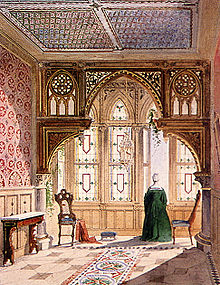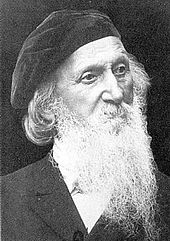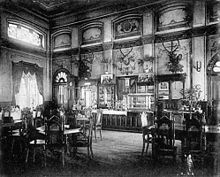Conrad Wilhelm Hase
Conrad Wilhelm Hase (born October 2, 1818 in Einbeck , † March 28, 1902 in Hanover ) was a German architect and university professor . He is considered one of the most important representatives of the neo-Gothic of the 19th century.
Hase was a royal Hanoverian building officer , from 1863 consistorial master builder of the Hanover regional church , from 1849 teacher and from 1878 professor of architecture at the Polytechnic in Hanover and founder of the Hanover architecture school , member of the Royal Prussian Academy of Arts in Berlin, member of the Academy of Fine Arts in Vienna , honorary member of the Academy of Fine Arts in Stockholm and honorary citizen of the cities of Einbeck and Hildesheim . His commitment to the preservation and care of historical buildings made him a pioneer in the preservation of monuments in northern Germany and beyond.
Life

Hase spent his childhood and youth as the tenth child of a tax collector in Einbeck , before he began studying architecture and building art in Hanover at the end of 1834. After completing his architecture studies, he did not find a job and returned in the spring of 1838 to his native Einbeck, where he helped his father with tax matters. On the advice of his architecture teacher Ernst Ebeling (1804-1851), Hase completed a two-year apprenticeship as a bricklayer, which he successfully completed in the spring of 1840 with the journeyman's examination. The instructor was the builder Christoph August Gersting . On a six-month wandering from Hanover via Kassel, Marburg, Frankfurt, Wiesbaden, Mainz, Worms, Speyer, Heidelberg, Karlsruhe, Stuttgart, Ulm, Augsburg to Munich, Hase was able to study various architectural styles. His preference for Gothic architecture was strengthened . A scholarship from the city of Einbeck enabled Hase to study at the Munich Art Academy at the end of 1840 .
In the spring of 1842 Hase returned to Hanover and initially found work as a bricklayer and site manager with his former teacher. In February 1843, Hase took on the job of a construction manager in the civil service of the Royal Hanover Railway Directorate, where he designed and managed the construction of the stations in Celle , Lehrte and Wunstorf . In June 1848, Hase turned to sacred architecture with the restoration of the monastery church in Loccum .
In December 1849, Hase took on a representative position at the Hanover Polytechnic . Two years later he was officially named as an architecture teacher and was one of the founders of the Architects and Engineers Association in Hanover , which contributed significantly to the dissemination of the ideas of the Hanover Architecture School through the publications he published. Various private commissions and the successful participation in the first free architecture competition in Hanover consolidated Hase's reputation as an architect.
In September 1853 Hase married Agnes Maria Cornelia Leguinia Babnigg (1828-1865), a singer of Hungarian descent. The couple had children Antonie (1855–1906), Theodor (1856–1877) and Rudolf (1861–1906). After his wife died at the age of only 37, he married Ottilie Franziska Annette Amalie Berckelmann (1832–1920) from Liebenburg in 1867 .
In 1860/61 Hase built a representative house for himself and his family on Josephstraße (today Otto-Brenner-Straße) in Hanover, the "Hasenburg". It was destroyed in World War II.
Hase's 80th birthday in 1898 was the reason for numerous honors from his students and admirers. In addition to his creative work, his personal friendliness and cheerfulness were also emphasized.
Style principles and effect
Hase's architectural style was influenced by medieval brick Gothic, whereby the construction of the buildings and the - preferably domestic - building materials used should remain visible to the viewer ( “plaster is a lie” ). Hase planned more than 340 buildings in the neo-Gothic style , including over 100 sacred buildings . He regarded the Gothic as the actually Christian architectural style. There are also over 150 restoration projects and numerous publications on the history of historical buildings.
Its brick Gothic, sometimes disrespectfully referred to as "Hasik", shaped the cityscape of Hanover and through its students ( Karl Börgemann , Franz Ewerbeck , Friedrich Fahro , Christoph Hehl , Karl Henrici , Rudolph Eberhard Hillebrand , Georg Kegel , Gerhard Franz Langenberg , Wilhelm Lüer , Karl Mohrmann , Edwin Oppler , Johannes Otzen , Max Pommer , Paul Rowald , Eduard Wendebourg , Johannes Franziskus Klomp and many others) numerous other places not only in northern Germany. Many public and private buildings, commercial buildings, churches and monuments have been preserved to this day. But his own house, the so-called "Haseburg", was destroyed in the Second World War. His grave is in the Engesohde city cemetery in Hanover. Hase was an honorary citizen of Hildesheim , where a street is named after him. His portrait can be found on a brick building in the street .
Work (selection)




- Mausoleum for Count Carl von Alten in Hemmingen-Westerfeld (1842)
- Railway stations in Celle , Lehrte , Wunstorf (1847–1848), Nordstemmen (1853–1860), Oldenburg (1879) and Göttingen and Salzderhelden
- Monastery church in Loccum (restored 1848–1854)
- Künstlerhaus Hannover (1853–1856) and Old Town Hall (restored 1877–1882, expanded 1890–1891) in Hanover
- Church of St. Marcus in Wettmar (1854–1855), sacral building in the arched style, then turning to neo-Gothic
- Oldershausen Castle in Kalefeld, ancestral seat of the von Oldershausen family (1859)
- John the Baptist Church (Hilter) (1857–1859)
- Evangelical Lutheran Church of St. John the Baptist in Uetze : 1865–1867, remodeling of the former church
- Evangelical Lutheran town church St. Jakobi in Elbingerode (Harz) (consecrated in 1863)
- Marienburg Castle (1857–1864) near Nordstemmen (1864–1867 completed by his student Edwin Oppler )
- Christ Church (1859–1864), Apostle Church (1880–1884) and Zionskirche / Erlöserkirche (1878–1880) in Hanover
- Dorotheenkirche in Nortrup-Loxten (1859/1860)
- Restoration of the churches of St. Michaelis (1855–1857) and St. Godehard (1857–1863) as well as a new school building for the Andreanum (1869) in Hildesheim
- Interior design of the St. Nikolai Church in Göttingen (1861)
- Residential and commercial building on Hauptstrasse in Wennigsen (1862)
- New building of the Ev.-luth. Church of St. Trinitatis in Lewe-Liebenburg (1862–1863; old church tower integrated)
- Restoration of the St. Nikolai Church in Lüneburg (1865–1871)
- Restoration of the minster church St. Bonifatius in Hameln (1870–1875)
- St. Antonius Church in Immensen (1877–1878)
- Restoration of the Frankenberg Church in Goslar (1873–1880)
- Reconstruction of St. Salvatoris Church in Clausthal-Zellerfeld (1863–1864)
- Saint Dionysius Church in Nettelrede (1862–1864)
- School building (1864) in Bordenau
- Schools in Bad Münder and Bakede
- Church of St. Georg (1867) in Eitzendorf (Hilgermissen) , model at the 1893 World Exhibition in Chicago
- Restoration of the Romanesque Sigward Church (1889–1890) in Idensen
- Comprehensive redesign of the St. Johannis Church Lüchow (1866)
- Catholic Church To the Holy Angels in Peine (1867)
- Elisabeth Church (1867–1869) in Langenhagen
- St. Martin Church in Markoldendorf (1867–1869)
- Church of St. Nicolai (1869–1871) in Hagenburg -Altenhagen
- Manor house (1869) and manor church (1875–1878) in Vollenschier
- Liebfrauenkirche (1870–1872) in Kalefeld
- Restoration of the Church of St. Magnus in Beber (1871–1872)
- School building of the Domgymnasium (1872) in Verden (Aller)
- Christ Church Bremerhaven-Geestemünde (1872–1875)
- Reconstruction of the Marienkirche (1872–1875) in Bremerhaven - Geestemünde
- Matthäuskirche (Lehrte) (1874/1876)
- St. Jakobi Church in Wietzendorf (1874–1876)
- Mausoleum in Etelsen Castle Park (1873)
- Evangelical Johanneskirche Tostedt (1876–1880)
- Evangelical Gustav Adolf Church in Gieboldehausen (1877)
- Churches with identical planning in Lauenau ( St. Lukas Church ) (1877–1878) and Georgsmarienhütte ( Luther Church ) (1877–1878)
- Evangelical St. Mauritius Church in Görsbach (1877–1878)
- Renovation and complete interior redesign of the collegiate church of St. Mauritius and St. Viktor in Bassum (1865–1870)
- Holle's house in Wunstorf (1880–1881), reconstructed from the remains of the wall
- St. Barbara Church (1882) in Seelze-Harenberg
- St. Antonius Church (1882–1884) in Fintel
- Gutskirche Schönfeld ( Bismark ) (1883–1885)
- New church (1887–1888) in Idensen , part of Wunstorf
- Sigwardskirche (Idensen) (from 1889/90), preservation of ornamental remnants with partial exposure
- Martinskirche (1884–1887) in Bernburg (Saale)
- Church of the Holy Cross (1857-1859) in Lehrte, Arpke district
- Tower of the church of Horst near Garbsen (1866/1867)
- Evangelical chapel in Nörten-Hardenberg in the Bishausen district (1883)
- Evangelical Lutheran St. Martini Church in Rhüden (1885–1888)
- Evangelical Church of the Redeemer in Berlin-Rummelsburg (1892)
- Extension of the John the Baptist Church in Mellinghausen (1893)
- New construction of the Martin Luther Church in Twistringen (1893–1894)
- Kreuzkirche in Katlenburg-Lindau in the district of Lindau (1895)
- New construction of the Christ Church Krummasel (1895)
- New construction of the Nicolaikirche in Kaltendorf, later Oebisfelde
- Church in Seelze, Dedensen district (1897)
Honors
- 1856 Gold Medal of Honor for Art and Science
- 1864 Guelph Order IV Class
- 1874 honorary member of the local building trade association for the city of Hanover and the surrounding area
- 1876 honorary member of the Architects and Engineers Association in Hanover
- 1879 Order of the Prussian Crown III. class
- 1881 honorary member of the Museum Association for the Principality of Lüneburg
- 1888 Norwegian Order of Saint Olav, 2nd class
- 1888 honorary member of the Stockholm Academy
- 1888 honorary citizen of the city of Einbeck
- 1888 honorary citizen of the city of Hildesheim
- 1889 Order of the Prussian Crown III. class
- 1892 honorary member of the art association in Hanover
- 1892 Commander's Cross 2nd class of the Saxon-Ernestine House Order
- 1893 honorary member of the Association of Berlin Architects
- 1894 Red Eagle Order II class
In the hundredth year of his death in 2002, an exhibition on the life and work of Conrad Wilhelm Hase was shown in the Christ Church . Due to the positive response to this event and in view of the upcoming 150th anniversary celebration, the church forecourt was renamed Conrad-Wilhelm-Hase-Platz in 2007 . There are also plans to renovate the station building in Nordstemmen , which is threatened with demolition, and to turn it into a museum memorial for the builder Conrad Wilhelm Hase.
Quotes
with reference to Conrad Wilhelm Hase:
- “If you want to identify Hase in a few words, then you have to say: He was a man in creativity, a youth in happiness and a child in disposition." - Karl Mohrmann, obituary for Conrad Wilhelm Hase, 1902.
with reference to your own teaching:
- "Plaster is a lie."
- "We want to create real and beautiful."
- "We want to practice truth in art."
- "Art is without lies and deceit."
Personal motto:
- “Everyone builds according to his nose, my name is Conrad Wilhelm Hase. Whoever wants to build on open roads has to be censured by envious people and fools. If you want to criticize this house, just stand still a little and say without flattery whether yours is better. And if you don't like my house, it won't cost mine your money. "
Personal epitaph:
- “Man's work rests in God's hands” - grave at the Engesohde city cemetery
about the Schaumburger Land , which Hase traveled to in 1855:
- "The whole country looks like a beautiful garden, and the friendly" Good morning! " a crowd of churchgoers in full old-fashioned Sunday cleaning transports us to the land of our childish dream world. "
student
- Julius Rasch (1830-1887)
- Edwin Oppler (1831-1880)
- Heinrich August Anton Gerber (1831–1920)
- Joachim Herrmann Evers (1838–1905)
- Franz Ewerbeck (1839-1889)
- Johann Mathias von Holst (1839–1905)
- Alexander Behnes (1843-1924)
- Wilhelm Walter (1850-1914)
- Carl Leopold Voss (1850-1937)
- Georg Fröhlich (1853–1927)
- Albert Winkler (1854–1901)
- Georg Kegel (1857–1912)
- Richard Kampf (1859-1919)
- Friedrich Wilhelm Karl Jacob (1850–1906)
literature
To the biography
- Karl Mohrmann : Conrad Wilhelm Hase. In: Hannoversche Geschichtsblätter . 1902 (also as a special edition Hannover 1902).
- Karl Mohrmann: From the life of a German artist. In: Centralblatt der Bauverwaltung. Berlin, April 1902.
- Wilhelm Rothert : General Hannoversche Biography Volume 1: Hannoversche men and women since 1866 , Sponholtz, Hannover 1912, pp. 148–155.
- Paul Trommsdorff : The faculty of the Technical University of Hanover 1831-1931. Hanover, 1931, p. 93.
- Emil Jörns: The family of the builder of the Marienburg Conrad Wilhelm Hase. In: Norddeutsche Familienkunde , 5th year 1956, page 41f.
- Hans Reuther : Hase, Konrad Wilhelm. In: New German Biography (NDB). Volume 8, Duncker & Humblot, Berlin 1969, ISBN 3-428-00189-3 , p. 22 ( digitized version ).
- Günther Kokkelink ; Monika Lemke-Kokkelink: Architecture in Northern Germany. Architecture and handicrafts of the Hanover School 1850–1900. Schlueter, Hannover 1998, ISBN 3-87706-538-4 . (Biography, overview of works: pp. 531–532).
- Helmut Knocke : Hase, Conrad Wilhelm. In: Dirk Böttcher , Klaus Mlynek, Waldemar R. Röhrbein, Hugo Thielen : Hannoversches Biographisches Lexikon . From the beginning to the present. Schlütersche, Hannover 2002, ISBN 3-87706-706-9 , pp. 153-154 ( Google Books ).
Catalog raisonné
- Günther Kokkelink and Monika Lemke-Kokkelink : Conrad Wilhelm Hase 1818–1902, founder of the Hanover School of Architecture. Exhibition on the 100th anniversary of death in the Hannover City Archives 2002. (List of works, status: February 2002, with dates of life and bibliographical information.)
- Conrad Wilhelm Hase. Builder of Historicism. Exhibition catalog. Historisches Museum am Hohen Ufer, Hanover 1968 (catalog raisonné with biographical dates and references.)
Others
- Gustav Schönermark : The architecture of the Hanover School. 7 volumes, Hanover, 1888–1895.
- Günther Kokkelink : The neo-Gothic Conrad Wilhelm Hases: A form of historicism. 1st part: 1818-1859. In: Hannoversche Geschichtsblätter , New Series , Volume 22, Issue 1/3, ISSN 0342-1104 , Hanover 1968, DNB 481563008 (Dissertation Technical University of Hanover , Faculty of Construction, July 11, 1968, 211 pages).
- Günther Kokkelink: The church building of Conrad Wilhelm Hase and his students in Hanover. In: Stories about Hanover's churches. Studies, pictures, documents. Lutherhaus Verlag, Hanover 1983; Pp. 113-117.
- Franz Rudolf Zankl (Ed.): Greeting card from the Kunstgewerbeverein for Conrad Wilhelm Hase on his 80th birthday , with the signatures of the members, in: Hannover Archive , Sheet K 19
- Gunther Schendel: House full of heaven. The St. Jakobi Church in Wietzendorf / Lüneburger Heide , Wietzendorf 2000 (on Hase and the Wietzendorfer Hase building, pp. 26–38).
- Nadine Pflüger, Werner Beermann: The architect Conrad Wilhelm Hase and his buildings from earlier times. Elze and Nordstemmen train stations . Issue 7 of the series of publications of the Heimat- und Geschichtsverein Elze and its districts e. V. , Elze 2007.
- Markus Jager, Thorsten Albrecht, Jan Willem Huntebrinker (eds.): Conrad Wilhelm Hase (1818–1902): architect, university professor, consistorial builder, preservationist. Petersberg 2019.
Web links
- Literature by and about Conrad Wilhelm Hase in the catalog of the German National Library
- Database on Conrad Wilhelm Hase's person, work and impact by Günther Kokkelink in collaboration with Monika Lemke-Kokkelink and Reinhard Glaß
- Karl Mohrmann: Obituary for CW Hase ( memento from December 8, 2006 in the Internet Archive ), Hannoversche Geschichtsblätter, Volume 5, Volume 5, pages 193-203, May 1902
Individual evidence
- ^ Helmut Knocke : Gersting, Christoph August. In: Hannoversches Biographisches Lexikon . From the beginning to the present. 2002, p. 130; Online source: [1]
- ↑ a b c biography of Günther Kokkelink
- ↑ Hase house (Kokkelink); the address “St.-Andreas-Straße” mentioned there can not be verified on the 1873 city map .
- ^ On the 200th birthday of Conrad Wilhelm Hase
- ^ Website of the church in Uetze
- ↑ To the city church of St. Jakobi in Elbingerode
- ^ Church of St. Trinitatis in Lewe-Liebenburg , accessed on February 5, 2012
- ↑ St. Dionysius Church , accessed on February 5, 2012
- ↑ Website of the parish Lüchow: Konsistorialbaumeister Conrad-Wilhelm Hase
- ↑ Monument topography of the Federal Republic of Germany, architectural monuments in Lower Saxony, Göttingen district, part 2, volume 5.3, 1997, edited by Peter Ferdinand Lufen, edited by Christiane Segers-Glocke, Verlag CW Niemeyer Buchverlage, Hameln, ISBN 3-8271-8257-3
- ↑ St. Mauritius Church in Görsbach , accessed on April 30, 2016.
| personal data | |
|---|---|
| SURNAME | Hase, Conrad Wilhelm |
| BRIEF DESCRIPTION | German architect and university professor, founder of the Hanover School of Architecture |
| DATE OF BIRTH | October 2, 1818 |
| PLACE OF BIRTH | Einbeck |
| DATE OF DEATH | March 28, 1902 |
| Place of death | Hanover |








